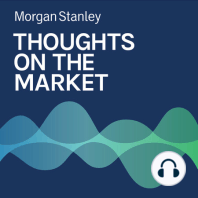3 min listen
Andrew Sheets: Big Moves From The Fed
ratings:
Length:
3 minutes
Released:
Jul 28, 2022
Format:
Podcast episode
Description
Yesterday, the U.S. Federal Reserve raised interest rates by another 75 basis points. What is driving these above average rate hikes and what might the effect on markets be?-----Transcript-----Welcome to Thoughts on the Market. I'm Andrew Sheets, Chief Cross-Asset Strategist for Morgan Stanley. Along with my colleagues, bringing you a variety of perspectives, I'll be talking about trends across the global investment landscape and how we put those ideas together. It's Thursday, July 28th at 4 p.m. in London. Yesterday, the Federal Reserve raised rates by 75 basis points, and the Nasdaq market index had its best day since April of 2020, rising over 4%. It was a day of big moves, but also some large unanswered questions. A 75 basis point rise in Fed funds is large and unusual. In the last 30 years, the Fed has only raised rates by such a large increment three times. Two of those instances were at the last two Federal Reserve meetings, including the one we had yesterday. These large moves are happening because the Fed is racing to catch up with, and get ahead of, inflation, which is currently running at about 9% in the U.S. In theory, higher fed rate should slow the economy and cool inflationary pressure. But that theory also assumes that higher rates work with a lag, perhaps as long as 12 months. There are a couple of reasons for this, but one is that in theory, higher rates work by making it more attractive to save money rather than spend it today. Well, I checked my savings account today and let's just say the rate increases we've had recently haven't exactly shown up. So the incentives to save are still working their way through the system. This is part of the Fed's predicament. In hockey terms, they're trying to skate the proverbial puck, aiming policy to where inflation and the economy might be in 12 months time. But both inflation and their policy changes are moving very fast. This is not an easy thing to calibrate. Given that difficulty, why did the markets celebrate yesterday with both stock and bond prices rising? Well, the Fed was vague about future rate increases, raising market hopes that the central bank is closer to finishing these rate rises and may soon slow down, or pause, its policy tightening as growth and inflation slow. After all, long term inflation expectations have fallen sharply since the start of May, perhaps suggesting that the Fed has done enough. And as my colleague Michael Wilson, Morgan Stanley's chief investment officer and chief U.S. equity strategist, noted on Monday's podcast, markets have often seen some respite when the Fed pauses as part of a hiking cycle. But it's also important to stress that the idea that the Fed is now nearly done with its actions seems optimistic. The last two inflation readings were the highest U.S. inflation readings in 40 years, and Morgan Stanley's economists expect core inflation, which is an important measure excluding things like food and energy, to rise yet again in August. In short, the Fed's vagueness of future increases could suggest an all important shift. But it could also suggest genuine uncertainty on growth, inflation and how quickly the Fed's actions will feed through into the economy. The Fed has produced some welcome summer respite, but incoming data is still going to matter, significantly, for what policy looks like at their next meeting in September. Thanks for listening. Subscribe to Thoughts on the Market on Apple Podcasts, or wherever you listen, and leave us a review. We'd love to hear from you.
Released:
Jul 28, 2022
Format:
Podcast episode
Titles in the series (100)
Mike Wilson: 3 Summer Surprises Investors Could Be Missing by Thoughts on the Market
